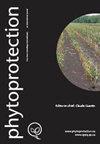Evaluation of host resistance inducers and conventional products for fire blight management in loquat and quince
IF 0.2
4区 农林科学
Q4 PLANT SCIENCES
引用次数: 12
Abstract
Fire blight disease is one of the most destructive diseases of pome fruits. Due to the lack of effective, non-phytotoxic and publicly acceptable materials for controlling fire blight in pome fruit trees, new strategies to manage Erwinia amylovora fire blight are being sought. The resistance-inducing compounds prohexadione-Ca, harpin protein and benzothiadiazole (acibenzolar-S-methyl), the fertilizer humic acid, the bactericides streptomycin and copper salts, and combinations of copper with chemicals were evaluated for their ability to control fire blight on quince and loquat cultivars. Prohexadione-Ca was applied at a rate of 125 mg L-1 at two shoot lengths (6-12 cm and 15-20 cm), while benzothiadiazole + metalaxyl (135 mg L-1) and harpin (50 mg L-1) were applied when the shoots measured between 15-20 cm, and again at 30-35 cm. On loquat cv. Cukurgobek, benzothiadiazole + metalaxyl showed about 60% effectiveness. The addition of copper salts reduced the effectiveness of benzothiadiazole + metalaxyl. On quince cultivars, streptomycin (P ≤ 0.05) was the most effective treatment during both years, followed by the harpin protein alone and in combination with copper salts. Prohexadione-Ca, benzothiadiazole + metalaxyl, and harpin protein applications reduced disease severity on inoculated shoots compared with copper and untreated controls. Prohexadione-Ca reduced both shoot length and shoot blight on the two hosts. Humic acid applications were ineffective in controlling fire blight on loquat and quince cultivars. Quince cv. Esme showed lower disease severity than cv. Ekmek (P ≤ 0.05). The use of resistance-inducing substances during the early phase of shoot growth may offer a means of managing the shoot blight phase of fire blight disease on quince and loquat.枇杷和温病防治寄主抗诱导剂和常规产品的评价
火疫病是对梨果实最具破坏性的病害之一。由于缺乏有效的、无植物毒性的和公众可接受的材料来控制梨树的火疫病,人们正在寻求新的策略来管理扁桃火疫病。评价了抗药诱导化合物prohexadi酮- ca、harpin蛋白和苯并噻二唑(酸苯甲酮- s -甲基)、肥料腐植酸、杀菌剂链霉素和铜盐以及铜与化学药剂组合对黄瓜和枇杷的防治效果。在6-12 cm和15-20 cm两个茎长处分别施用125 mg L-1的prohexadion - ca,在15-20 cm处分别施用苯并噻二唑+甲axyl (135 mg L-1)和harpin (50 mg L-1),然后在30-35 cm处再次施用。论枇杷cv。Cukurgobek、苯并噻唑二唑+甲氨苄有效率约60%。铜盐的加入降低了苯并噻二唑+甲酰基的有效性。在两种年份中,链霉素(P≤0.05)是最有效的处理,其次是harpin蛋白单独处理和铜盐联合处理。与铜和未经处理的对照相比,施用Prohexadione-Ca、苯并噻二唑+甲axyl和harpin蛋白降低了接种苗的疾病严重程度。Prohexadione-Ca减少了两个寄主的茎长和茎枯萎病。腐植酸对枇杷和榅桲品种的防治效果不显著。贴梗海棠的履历。Esme的疾病严重程度低于cv。Ekmek (P≤0.05)。在嫩枝生长初期使用抗病诱导物质,可为控制温、枇杷的火枯病嫩枝期提供一种方法。
本文章由计算机程序翻译,如有差异,请以英文原文为准。
求助全文
约1分钟内获得全文
求助全文

 求助内容:
求助内容: 应助结果提醒方式:
应助结果提醒方式:


